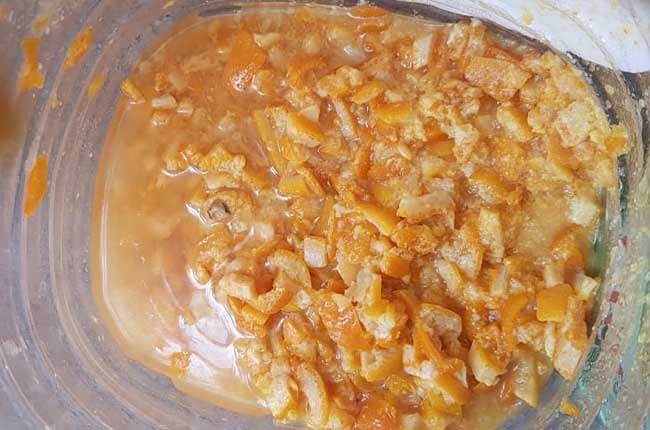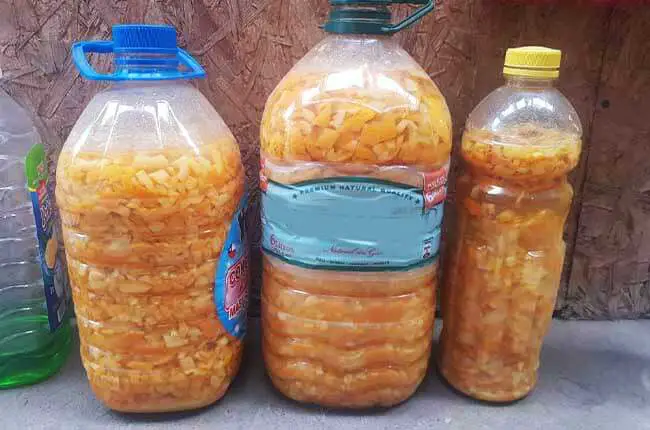Some people fertilize their orchids using things from the kitchen, like coffee, milk, or even bananas.
However, not anything natural is a good fertilizer for indoor orchids, which are mostly epiphytic (or orchids that do not grow in soil).
Since most orchids do not grow like most plants in soil, a good natural fertilizer should be water-based without solids and is well fermented for immediate nutrient uptake. It’s a myth to put coffee, egg shells, milk, rice water, etc. to an orchid and expect it to absorb nutrients like humans.
This article will first debunk the myth of some of the frequently recommended natural orchid fertilizers. I will also explain the type of natural fertilizers that really works for orchids and provide a tried-and-true DIY fertilizer recipe that I have used to successfully produce healthy orchids with big blooms.
What makes a GOOD natural fertilizer for orchids?
Natural fertilizing is much more than just dumping an organic substance to our plants. It requires a holistic eco-system with healthy communities of micro-organisms, the right temperature, moisture, pH, and time to break down large molecules of nutrients in organic materials into smaller chemical molecules before they can be absorbed by the roots of the plant.
The principle behind organic fertilizing is to feed the soil, instead of the plants. We provide enough organic substances to feed the microbes living around the roots so they can digest the food and break it down into nutrients slowly for the plants.
Microbes in the soil can take between a few weeks to a few months to metabolize the large molecules in the organic matter such as protein into smaller molecules such as nitrates before they can be absorbed by the roots.
But, since epiphytic orchids do not grow in soil, the way to fertilize epiphytic orchids naturally should not be aiming at feeding soil microbes for a slow release of nutrients. Rather, an immediate release of nutrients is needed.
Apart from that, what makes natural fertilizing more difficult for orchid growers is that the way most orchids are grown at home is not natural to its native habitat. That includes
- growing orchids in pots
- growing orchids indoor
- growing orchids in a moss and bark medium
- flushing or soaking orchids from time to time to prevent salt buildup on the roots
- changing the medium every 1-2 years to prevent decomposition and root rot
So, what makes a good natural fertilizer for orchids? A good natural fertilizer suitable for growing orchids in indoor settings should have the following characteristics: - It is water-based to facilitate a fast release of nutrients - It does not contain solids that can clog the orchid medium and reduce ventilation to the roots - the organic substances are well-fermented with nutrients broken down into small molecules for immediate uptake - it does not produce a foul smell - it does not attract gnats and pests - its production is economically and environmentally sustainable (with resources easily accessible, without needing to purchase from afar)
Natural orchid fertilizers that do NOT work
There is nothing wrong with fertilizing plants in a natural way – natural fertilizers do work. But, many people make it sound overly simplistic.
Their recommendation often goes: milk (or any organic substance) is good for orchids because it is rich in protein, amino acids, calcium, etc. The recommendation often ends there without explaining further how the claimed vitamins and nutrients can benefit orchids, and if they can really be absorbed by orchids. Many people assume that the food humans eat would also be good for plants and can be absorbed by them.
In the following, I will show the problems with some of these commonly recommended natural fertilizers for orchids.
– Coffee
Using coffee to fertilize orchids is one of the major myths. This may be a little difficult to believe at first, because coffee DOES work as a fertilizer for plants in the garden (with soil). But, not so much for epiphytic orchids.
There are several problems using coffee grounds to fertilize orchids. First, they can clog the moss medium, reducing airflow to the roots and thus increasing the risk of root rot.
Also, coffee grounds take a long time, at least a few weeks, for the protein to be broken down by microbes and to release its nitrogen for the roots to absorb. Since epiphytic orchids do not grow in soil, it is questionable if there are enough microbes, if at all, around the roots to break down the nitrogen. Coffee grounds can also attract gnats and pests in the process of decomposition.
Just using liquid coffee with the coffee grounds filtered out does not work either because it contains almost no nutrients usable for orchids.
If you want to know more, here is an in-depth article about the problem of using coffee as orchid fertilizer.
– Tea
Soaking orchid roots in tea is often recommended for its high nitrogen content. First, the tiny portion of leaves in a tea bag is not going to contain much nitrogen. Second, the nitrogen molecules cannot be absorbed by the roots before they are converted by microbes into nitrates.
Tea is also recommended for its auxin content, a plant hormone for stimulating root growth. But, auxin is highly unstable and is easily destroyed by heat during the production into tea bags. (Here is an article about using kelp extract to feed plants with auxin)
It is highly doubtful that there are any nutritional benefits of soaking orchids in tea. Moreover, it is not worth it to feed your orchid with tea while there are other much cheaper and effective fertilizer options.
– Egg shells
Egg shells are often recommended to be baked, grounded into powder and then sprayed on orchid leaves or applied directly to the medium. The claim is that burnt egg shells provide orchids with calcium phosphate.
The problem is similar to that of coffee grounds. Egg shell powder can clog orchid medium, reducing airflow to the roots.
And applying eggshell powder on leaves will not work as the protein molecule is too big to go through the tiny pores on the leaves (To learn more about foliage fertilizing).
– Rice water / Potato cooking water
It is claimed that the water used to wash rice or to cook rice is rich in vitamin B, and other nutrients such as folic acid, niacin, riboflavin and thiamin. But, how do they benefit orchid growth? Does orchid need vitamin B at all?
The problem with applying rice water to orchids is that when it ferments, it can give an unpleasant smell and can attract gnats, accelerating the decomposition of the orchid medium. (To learn more about the problems of using rice water to fertilize orchids)
– Milk
Milk is recommended for orchids for its protein content. But, how can orchids absorb protein? Protein is a big molecule which must be broken down into smaller ones such as nitrates before they can be absorbed by the plant. Just feeding an orchid with milk is useless and a waste of food.
Moreover, the milk left in the medium would turn sour after a couple of days, attracting gnats and fungal problems.
Best Natural Orchid Fertilizer (RECIPE)
My favorite organic fertilizer is fermented citric fruit juice, which is easy to make and has been used with much success on my orchids.
Formula
3 parts citric fruit peels, 1 part sugar, 10 part water. Citric fruits can be orange, lemon, grapefruit, pineapple, etc.

Method
1) Find any unused plastic bottle, better with a wide mouth. Measure the height and divide into 14 parts.
2) Fill 1 part of the height of the bottle with white sugar. Then, put in tap water to fill 10 more parts.
3) Chop citrus fruit peels into small parts, big enough that can be put inside the bottle. Cutting the peels is to open up more surfaces of the fruit to ferment naturally. If there are not enough fruit peels to fill 3 more parts in one go, you can put in the chopped peels every day until your bottle fills up.
4) Let the mixture ferment for 3 months. Do not screw the lid too close during the first couple of weeks as the fermentation process generates much gas.

Benefits for orchids
- Using the peel of citric fruits instead of other fruits such as banana or even vegetables has the advantage of repelling gnats and pests because of the citric smell.
- Also, the resulting fermented concoction gives off a pleasant smell of fruit juice, rather than a foul rotten smell—an important aspect for growing orchids indoor.
- Fruit peels are easily accessible and it is a sustainable way to recycle kitchen waste.
- A well-fermented orange peel concoction after a month of fermentation would have the macronutrients and micronutrients readily available for immediate uptake. For 100g of raw orange peels, there are 1.5g protein (nitrogen), 161mg calcium, 212mg potassium and 0.8mg iron that are useful nutrients for orchid growth. It also have potassium and phosphorous.
- Apart from the benefits of nutrients, the fermentation produces succinic acid and lactic acid, both are well known for promoting plant growth.
- The mixture is also low in pH which orchids prefer.
Results
I only water my orchids with this fermented fruit juice diluted at least 20 times in water. After a few months, my dying orchids slowly perked up, produced healthy roots, huge leaves, strong flower spikes and big beautiful blooms. What’s more, the fermented fruit juice smells so lovely, just like a strong orange juice!
Conclusion
Many of the so-called homemade fertilizers such as coffee/coffee grounds, egg shells, rice water, milk, etc. do not work for orchids. This is mostly because orchids do not grow in soil and their medium needs to be changed every 1-2 years, so there are no microorganisms around the root area to break down the large organic molecules into smaller ones for easy absorption.
On the other hand, organic substances would actually be stuck in the medium, making the orchid more vulnerable to pests and fungal problems.
A good natural fertilizer for orchids should be a well-fermented liquid with organic substances well broken down into small molecules with nutrients readily available for immediate uptake when poured into the orchid medium. Also, it should not produce an unpleasant smell or attract pests.
To fulfill these criteria, fermented citric fruit juice is a good natural fertilizer for orchids, by fermenting citric fruit peel with sugar and water for a couple of months. Not only would this give you a strong healthy orchid, but it would also give off a pleasant and uplifting citric fruit smell.
Happy growing!
Related articles
Orchid Nutrition and Fertilizer: A Complete Guide
Orchid Nutrient Deficiency: Symptoms & Solutions (Pictures)
Sources
Nutritional value of orange peel, raw
Rushing, J. (2015). Indigenous Microorganism 4 (IMO 4) as a Soil Inoculant. Faculty of the Tropical Conservation Biology and Environmental Science at the University of Hawai’i at Hilo. Unpublished Thesis: https://dspace.lib.hawaii.edu/handle/10790/2598
Yoshikawa, Emon & Hirai, Nobuhiro & Wakabayashi, Kohji & Sugizaki, Haruyuki & Iwamura, Hajime. (1993). Succinic and lactic acids as plant growth promoting compounds produced by rhizospheric Pseudomonas putida. Canadian Journal of Microbiology. 39. 1150-1154. 10.1139/m93-173.
- Top 6 Drip Irrigation Systems for Raised Beds (2025) - January 31, 2025
- Top 10 Orchid Fertilizers: A Comprehensive Review (2025) - January 16, 2025
- Top 6 Slow-Release Fertilizers for Houseplants & Veggies (2025) - January 15, 2025

